A heaping bowl of bright orange butternut squash swimming in creamy coconut curry is just the welcoming kind of quick Thai meal to warm the soul on chilly nights. It's also gluten free and cook in less than 20 minutes.

This recipe really works well for chilly fall days when pumpkins abound or just whenever you'd like a light lunch or filling plant based meal.
Other vegan fall favorites to try are honeynut stuffed squash, green bean casserole with coconut milk, or millet porridge.
Jump to:
Why You'll Like this Recipe
- Brimming with fresh vegetables including spinach, so you don't have to serve a separate green vegetable on the side.
- After the vegetables are chopped, it just takes about 15 minute to cook on the stovetop.
- A premade curry paste does most of the work providing the flavor in this dish, so you don't have to pound one from scratch.
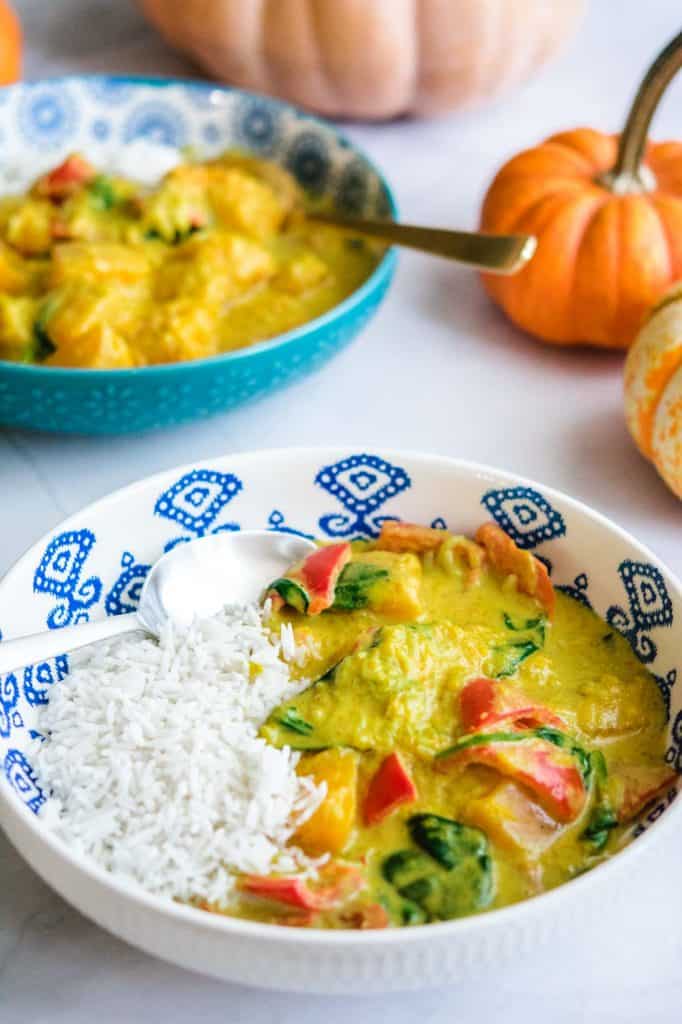
The problem with most premade curry pastes for vegans
Unless you make your own curry paste, which requires about 10 plus ingredients, the store bought versions often contain shrimp paste.
There are some exceptions. Most notably with the yellow curry paste from the Mae Ploy brand.
For other brands, you need to read the ingredient list to ensure there is no shrimp paste or fish sauce, if you're making vegan curry.
Ingredients
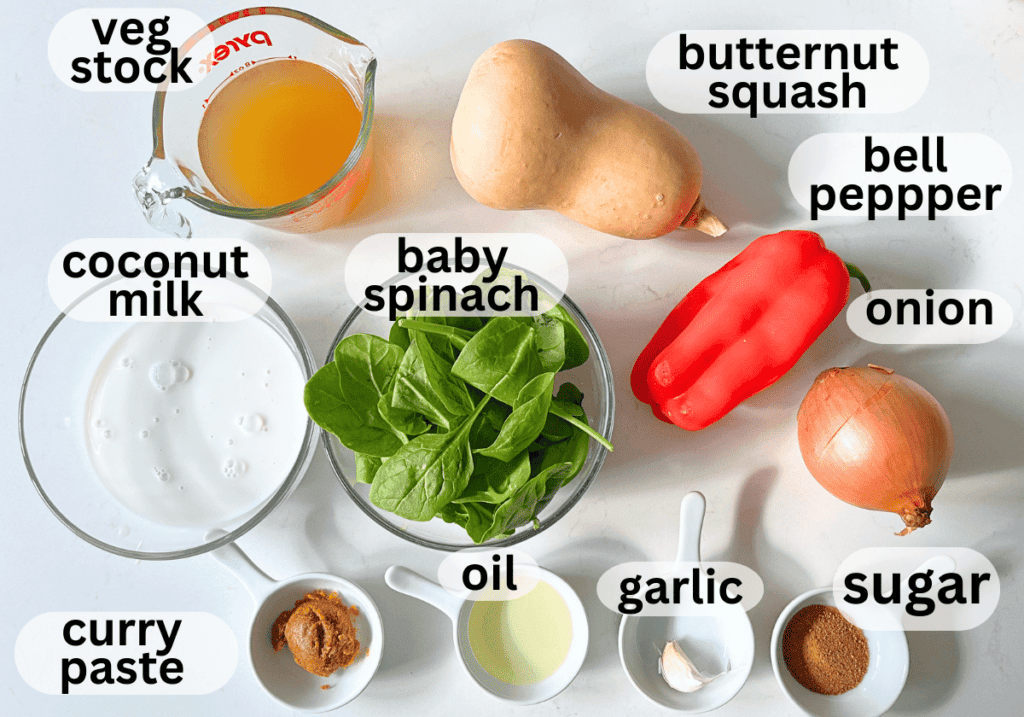
- Butternut squash - The squash should be peeled, deseeded, and diced, or you can buy the ready to go chunks. With its long neck and flat bottom, butternut squash has a bit more of a watery, fibrous texture compared to a creamier pumpkin like kabocha or acorn squash. Its distinctive, bright orange color, sweeter more concentrated flavor than its round, larger counterparts make it a chef's favorite.
- Vegan yellow curry paste - Use a premade curry paste such as the yellow curry paste from Mae Ploy or another brand that does not contain any shrimp paste or seafood ingredients. The Mae Ploy brand curry paste contains the following ingredients: garlic, lemongrass, salt, shallot, galangal, dried red chili, coriander seed, kaffir lime peel, curry powder, cumin, cinnamon, turmeric, cinnamon, nutmeg. Note that this brand tends to be salty, and thus requires less additional salt/tamari. I've found the Thai Kitchen brand to be not salty at all and requires double the addition of salt or tamari.
- Red bell pepper - The pop of red contrasts nicely with the butternut quash, and bell peppers cook quickly.
- Baby spinach - Stirred in at the end, spinach is an easy way to add greens to any dish including this curry.
- Coconut milk (unsweetened)- Regular or light coconut milk works in this recipe. This is the distinct ingredient found in most Thai curries (with some notable exceptions like jungle curry). The sweet creaminess of the coconut, balances out the spicy, punchy, salty curry paste. The thickness of the milk really varies quite a bit from brand to brand. Chaokoh tends to make the thickest version with other being notably more watery.
- Vegetable stock - If your coconut milk is really thick, you will need some extra liquid to thin it out. Water works too, but veg stock adds more flavor.
- Onion and garlic - You really need some aromatic vegetables to freshen up the premade curry paste that's been sitting on the store shelf.
- Coconut sugar - Or brown sugar works too. Some Thai restaurants add a lot of sugar to balance out the intense curry paste. By making it at home, you get to control the amount of sweetness. Add more or less to your taste.
- Cooking Oil - You'll need just a dab to fry the curry paste. You could also use the hardened coconut cream from the can of coconut milk.
- Turmeric powder (optional) - You don't have to add this. but it gives the curry an extra, bright yellow color and some added health benefits.
See recipe card for quantities.
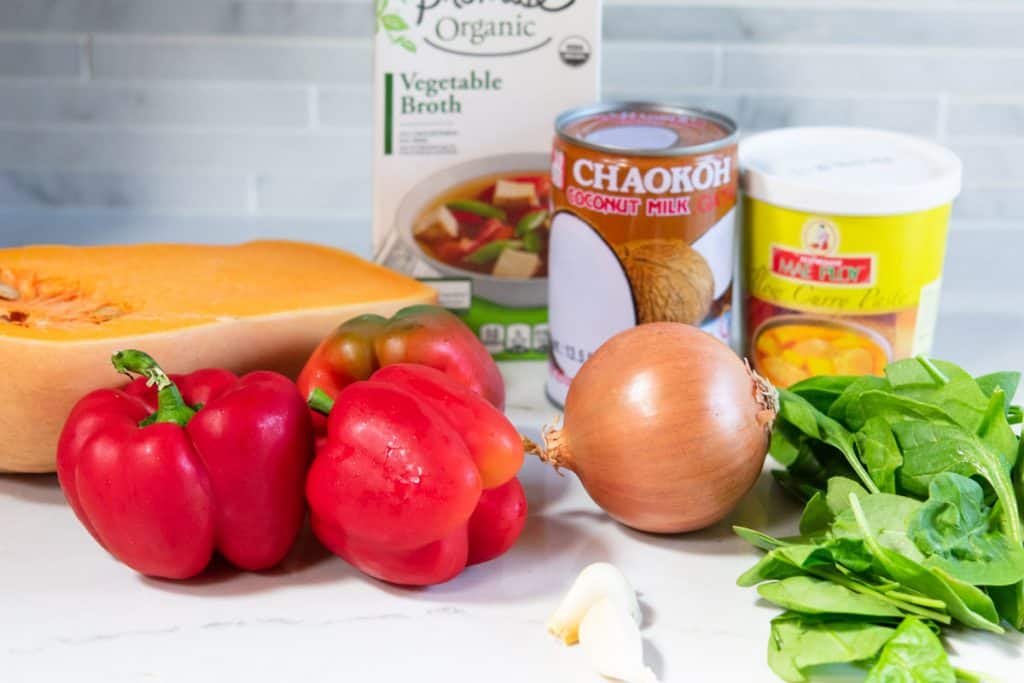
Secret Ingredient?
To be honest, sometimes this dish can be amazing or it can be lacking, depending on the quality of the butternut squash. Like choosing a watermelon, you don't know how sweet it really is until you taste it.
Most curries are seasoned not just with vegetables but with some meat or fish. Since this curry only has vegetables and no fish sauce, it can taste really lean.
If you taste the pumpkin with the curry at the end of cooking and feel like it still needs something, you can mix some of the liquid with 2-3 tablespoons of almond butter or peanut butter to give it some extra sweetness and heft and pour that back into curry.
Instructions

Chop the vegetables. You want to get them evenly sized as possible, so they cook at the same rate. You could also buy prechopped butternut squash, if you don't like cutting it.

Heat the oil over medium high heat in at pot (at least 3 qt size). Add the curry paste, onion, and garlic.
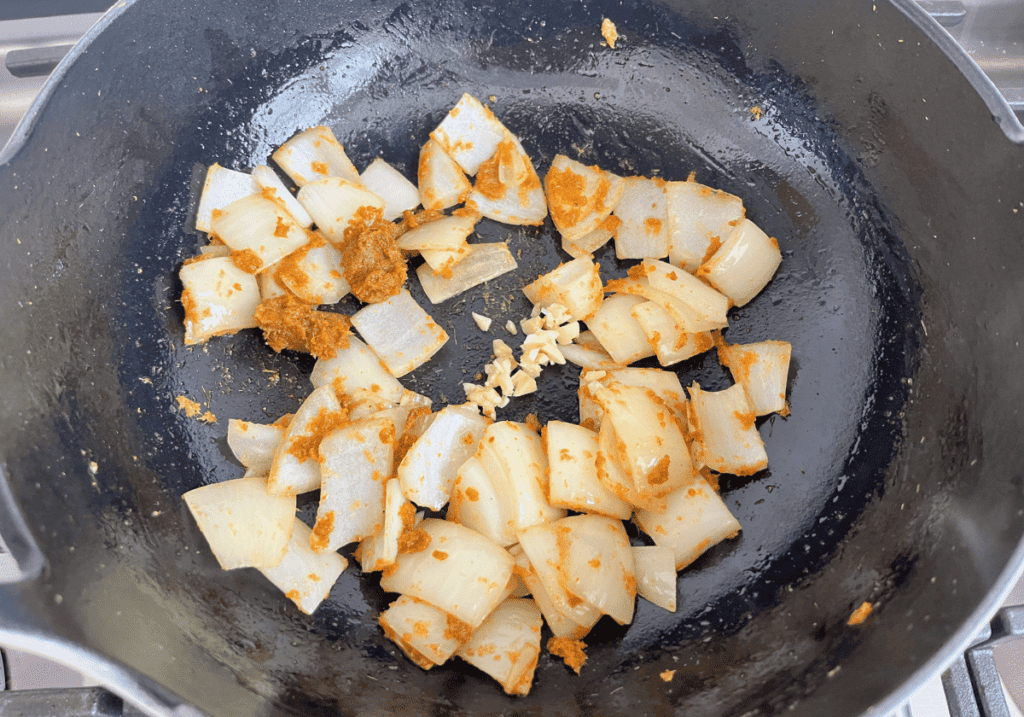
Stir fry for 1-2 minutes to bloom the flavors.

Add the coconut milk, vegetable stock, butternut squash, and sugar. Bring to a gentle simmer (low bubble). Then lower to medium heat.

After 6-8 minutes, add the red bell pepper. This is about halfway through cooking of the butternut squash which will take 10-15 minutes to cook through, depending on the size of the chunks.

Add the turmeric if using. You can see it really adds a nice yellow color to the coconut milk. It's also time to taste. Is your butternut squash sweet? Do you have enough salt? Add more sugar, salt, or tamari as needed.

After 5-8 minutes, the red bell pepper and butternut squash should be tender. Add the baby spinach and cook for 1-2 minutes.

The baby spinach should just be wilted and still bright green. Serve hot with jasmine rice, cauliflower rice, or rice noodles.
Hint: Baby spinach overcooks quickly and gets slimy. Avoid overcooking once it's been added to the pot.
Substitutions
- Other Squash and Pumpkins - Zucchini, delicata squash, or regular orange pumpkins will work too. Just adjust the cooking time.
- Kale - Instead of spinach, you could use kale or another dark, leafy green.
Variations
- Noodle Soup - Instead of serving with rice, you could serve over some cooked brown rice noodles or regular rice noodles. They taste so good when they soak up that curry sauce.
- Protein Packed - Add some cubes of fried tofu to simmer with the pumpkins. Instead of sticking in raw tofu, I like to bake them in the oven or air fryer for 10-15 minutes with some oil, so they can develop a little bit of crust and carmelization. They'll absorb plenty of flavor from the coconut curry sauce.
- Rainbow - Add purple potatoes, sweet or regular, and butterfly pea flower rice and you'll just about have all the colors of the rainbow in this bowl.
- Spicy - Did you want to feel fire on your tongue next to the sweet, creamy squash? Add some fresh chopped jalapenos or other chili to the pot with the onion and garlic.
Equipment
- 3 qt saucepan or larger with a lid to cover
- Heatsafe stirring utensil
- Cutting board and knife
- Vegetable peeler
Storage
Store up to 3 days in the fridge.
You could freeze this in an airtight container for up to 1 month, but the integrity of the fresh vegetables will deteriorate slightly. It comes together quickly enough, you should be able to make this any night of the week.
Helpful Tips
- Use a yellow curry paste or other colored curry paste that does not contain any animal products such as fish sauce or shrimp paste, if you would like to keep this recipe vegan. I used the Mae Ploy brand which tends to be salty, and thus requires less additional salt/tamari. I've found the Thai Kitchen brand to be not salty at all and requires double the addition of salt or tamari.
- If you don't care to peel and cut butternut squash, try using delicata squash. You don't have to peel it, and it is much easier to cut. You can also buy precut butternut squash from the store.
- If you taste the pumpkin with the curry at the end of cooking and feel like it still needs something, you can mix some of the liquid with 2-3 tablespoons of almond butter or peanut butter to give it some extra sweetness and heft and pour that back into curry.
- If you prefer to dump everything in a pot all at once, that will work too. Stir frying the paste and vegetables separately just adds a little more nuance and develops more distinct flavors. Just make sure to add the baby spinach at the end to avoid overcooking.
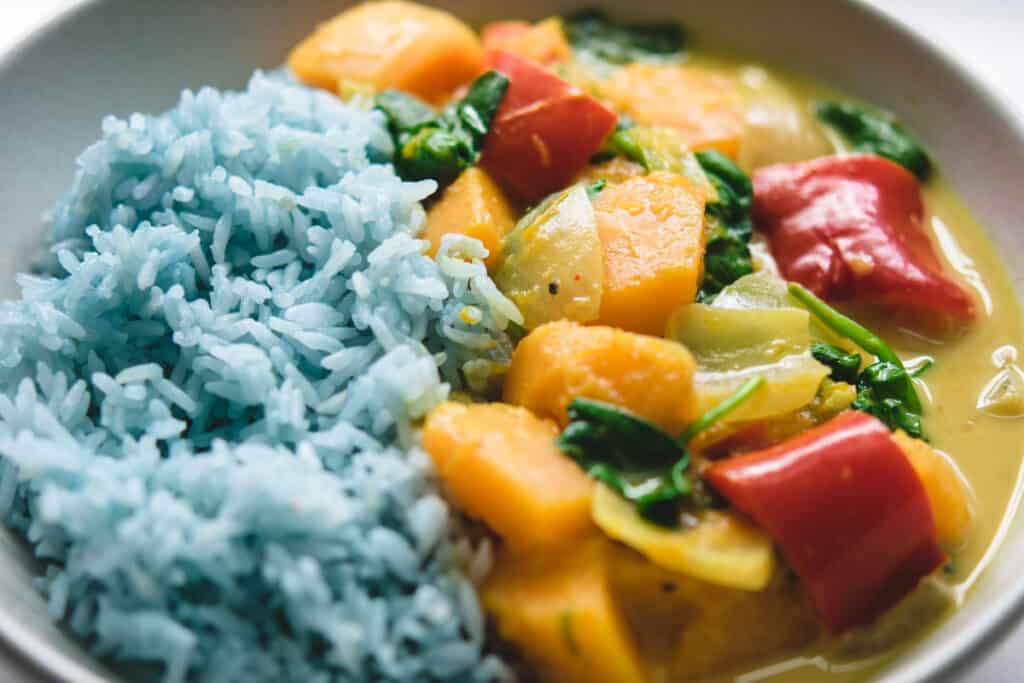
FAQ
The difference is the type of different type of ingredients that are smashed into the curry base of lemongrass, garlic, shallot, galangal, and cilantro root to name a few of the ingredients. Yellow curry paste has the addition of turmeric, which makes it yellow. Red curry paste has dried red chiles ground into the paste. Green curry paste has lots of fresh herbs like cilantro and makrut limes.
If a regular curry is Indian curry, Indian curries typically use water or dairy in their curry broth and little if any sugar. Thai curries typically use coconut milk and sugar to balance out the spice and heat of the curry paste.
It can be either depending on where you buy it from and who made it. I've found Thai curries in Thailand to be screaming spicy while Thai curries in American restaurants can range from slightly to cloyingly sweet. It all depends on how much chili and sugar the cook decides to add.
Related Plant Based Recipes
More Vegetarian Recipes
Recipe
Vegan Thai Butternut Squash Curry
Ingredients
- 1 Tb oil
- 1 clove garlic minced
- 1 Tb yellow curry paste with no shrimp paste, such as Mae Ploy; see Note 1
- 1 ea small onion, diced cut into a large dice, this is a bout 1 cup of chopped onion
- 1 lb butternut squash cut into 2 large 2" chunks; this is about 4 cups of chopped squash; see Note 2
- 1 can coconut milk 13.5-14 oz
- ½ c vegetable stock
- 4 teaspoon coconut sugar or 2 teaspoon brown sugar
- 2 teaspoon tamari or soy sauce
- 1 ea red bell pepper cut int 2" chunks
- 2 c baby spinach loosely packed, about 2 handfuls
Optional
- ¼ teaspoon turmeric
Instructions
- Heat the oil over medium high heat in at pot (at least 3 qt size). Add the curry paste, onion, and garlic. Stir fry for 1-2 minutes to bloom the flavors.
- Add the coconut milk, vegetable stock, butternut squash, and sugar. Bring to a gentle simmer (low bubble). Then lower to medium heat.
- After 6-8 minutes, add the red bell pepper. This is about halfway through cooking of the butternut squash which will take 10-15 minutes to cook through, depending on the size of the chunks.
- Add the turmeric if using (to add a nice yellow color to the coconut milk).
- t's also time to taste. Is your butternut squash sweet? Do you have enough salt? Add more sugar, salt, or tamari as needed. See Note 3 if your squash does not taste so great, and you need a flavor boost.
- After 5-8 minutes, the red bell pepper and butternut squash should be tender. Add the baby spinach and cook for 1-2 minutes.
- The baby spinach should just be wilted and still bright green. Serve hot with jasmine rice, cauliflower rice, or rice noodles.
Notes
- Use a yellow curry paste or other colored curry paste that does not contain any animal products such as fish sauce or shrimp paste, if you would like to keep this recipe vegan. I used the Mae Ploy brand which tends to be salty, and thus requires less additional salt/tamari. I've found the Thai Kitchen brand to be not salty at all and requires double the addition of salt or tamari.
- If you don't care to peel and cut butternut squash, try using delicata squash. You don't have to peel it, and it is much easier to cut. You can also buy precut butternut squash from the store.
- If you taste the pumpkin with the curry at the end of cooking and feel like it still needs something, you can mix some of the liquid with 2-3 tablespoons of almond butter or peanut butter to give it some extra sweetness and heft and pour that back into curry.
- If you prefer to dump everything in a pot all at once, that will work too. Stir frying the paste and vegetables separately just adds a little more nuance and develops more distinct flavors. Just make sure to add the baby spinach at the end to avoid overcooking.
Nutrition
Food safety
- Do not use the same utensils on cooked food, that previously touched raw meat.
- Don't leave food sitting out at room temperature for extended periods.
- Never leave food that is still cooking unattended.
- Use oils with high smoking point to avoid harmful compounds.
- Always have good ventilation when using a gas stove.
See more guidelines at USDA.gov.
Fortune Cookie 🥠
Both healthy and unhealthy behaviors are contagious.
Psychologist, Dr. Ellen Hendriksen
Lucky Cat 🍀 🐈

I am allowed to rest while building my dreams.



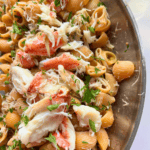



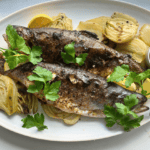
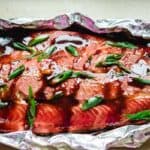
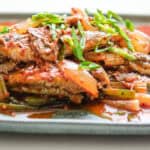


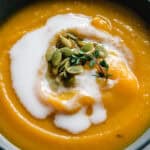





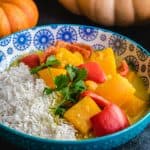


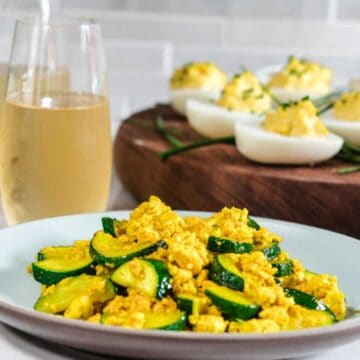
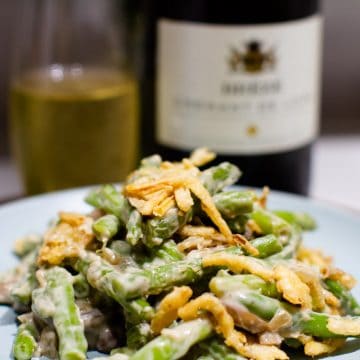

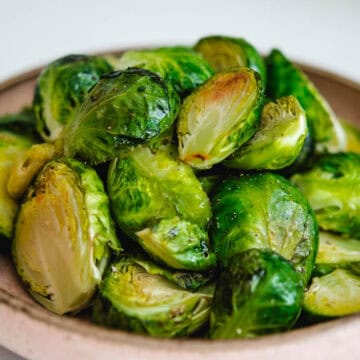

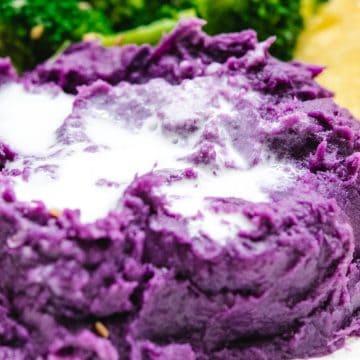


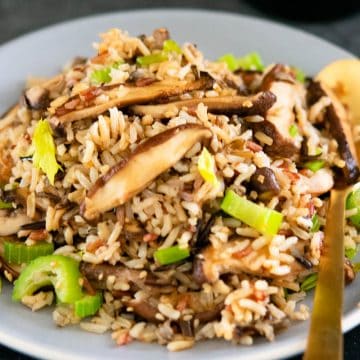
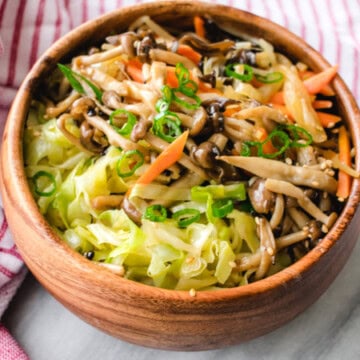

Leave a Reply